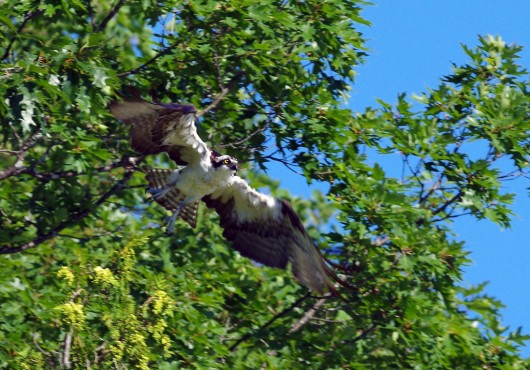The first dustings of snow have fallen. And yes it’s “sticking,” though there’s no accumulation yet to contend with. Long Lake is teeming with mergansers, black ducks and buffleheads. But I’ve still not boasted properly of all the winged things we’ve seen this year.
We had more Bald Eagle sightings than any other year. Since the eagles don’t migrate we’re hoping to continue the sightings through the winter. But it will be more difficult now that we can’t float around on the lake. Snow shoes will be an option soon though.
What a creature. What a great blue-sky day that was.
We watched a Great Blue Heron patiently stalking prey on the shores of Ghost Bay for at least half an hour one early morning. We tired of watching before the heron tired of stalking. When we are patient ourselves, and quiet like the heron, we can drift around in our kayaks and not disturb the hunting. A few times the heron looked like it was doing the heron equivalent of salivating, but we didn’t see it catch anything.
We watched this osprey in one of the dead trees in the south lobe of the lake, very near to the narrows, for a good bit. Steve was minus his best camera for wild life photography, so maybe the tree is the star more than the osprey. But what a pair! You need to check Andrew Defrancesco photography if you need inspiration from the photos.
And when the sea gulls are not trying to snitch french fries from the Alpena McDonald’s/Home Depot parking lot, they can be quite the dignified bird.
This one was perched, late in the fall, on what remained of the “this-will-kill-your-prop” now-submerged rock pile near Belly Button Island. We imagine it hadn’t gotten to stand on those rocks all summer because it wasn’t anywhere near the top of the pecking order. There are still some gulls on the lake. Maybe this one is still sitting on the rock, making it look like he can walk on water.
There is some disturbing news, though. We were quite sure this year’s adolescent loon had flown off nearly a month ago. Steve saw it take flight and head high and upward. We are hoping that the little goofball didn’t get mixed up. But whether its “our” adolescent or another who just happened to make its way somehow to Long Lake, as of November 15th, with the snows closing in, there is still an adolescent loon on the lake.
Honestly, this one–who we haven’t seen up close for a few weeks–looks to be smaller and somewhat lighter colored than the young one we watched all summer. We worry it’s this year’s chick, which certainly seems likely, and that it’s ailing. This photo was taken in early November. But we saw him yesterday, November 15th. He’d caught a fish.
Last year the adolescent didn’t leave until mid-November, so it’s still possible this one will take flight and head south before the lake freezes. “Fly, fly, fly!”










